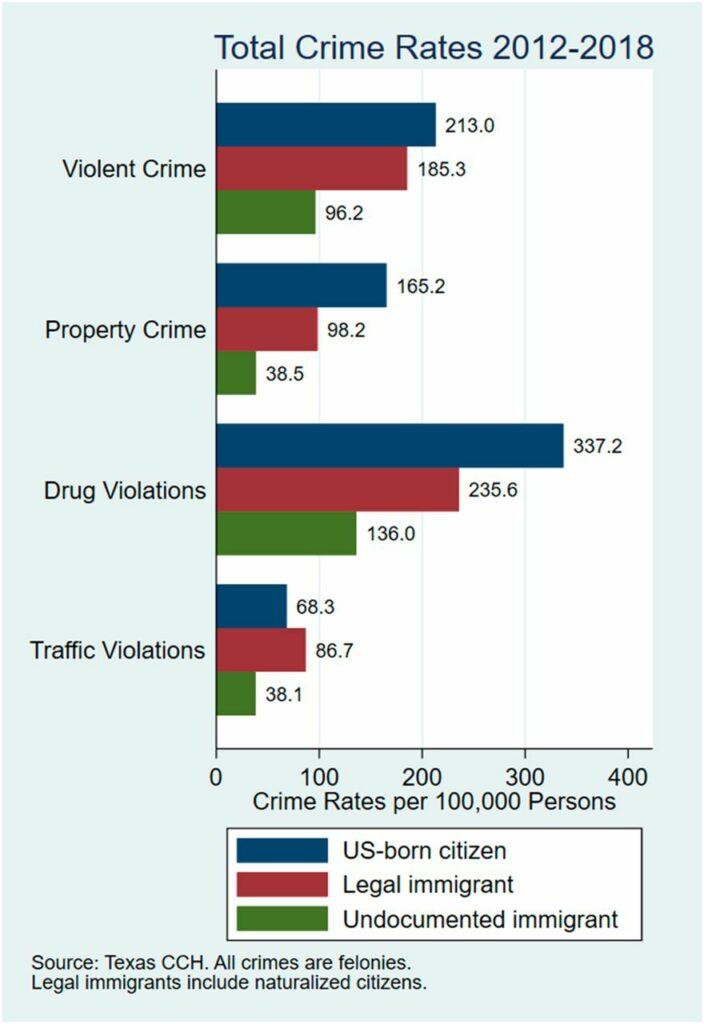Recent discourse in the United States has seen a resurgence of false claims linking immigration to rising crime rates, sparking heated debates across the political spectrum. This article delves into the underlying factors driving these misconceptions, examining the role of misinformation, political agendas, and media representation in shaping public perception. By unpacking the data and expert analyses, we aim to provide a clearer understanding of the reality behind immigration and crime, challenging the narratives that have fueled division and fear.
Immigration and Crime Statistics Debunked by Experts
Experts consistently emphasize that the purported link between immigration and rising crime rates is misleading and often based on selective data. Comprehensive studies show that immigrant communities, particularly those who have recently arrived, tend to have lower crime rates compared to native-born populations. This disparity is attributed to several socioeconomic factors, including stronger community bonds and heightened awareness of legal consequences. Additionally, some reports fail to adjust for variables such as age, economic status, and geographical location, which can skew interpretations, perpetuating stereotypes and unfounded fears.
Recent research from criminal justice scholars and federal agencies reveals the following insights:
- Immigrants are less likely to commit violent crimes than native-born citizens.
- Increased immigration enforcement does not correspond to a drop in overall crime rates.
- Misclassification of data by media outlets fuels inaccurate narratives.
| Group | Violent Crime Rate per 1,000 Residents | Property Crime Rate per 1,000 Residents |
|---|---|---|
| Native-born | 5.2 | 16.7 |
| Immigrants (Legal) | 2.1 | 8.3 |
| Immigrants (Undocumented) | 2.7 | 10.5 |
How Misinformation Spreads Through Social and Traditional Media
False narratives often gain traction through a complex interplay between social and traditional media platforms. Social media’s rapid dissemination capabilities allow misleading claims to reach vast audiences quickly, frequently fueled by sensational headlines and emotionally charged content. Algorithms designed to maximize user engagement further amplify misinformation by prioritizing posts that trigger outrage or fear, making it harder for accurate information to break through. Traditional media, meanwhile, can inadvertently contribute to the spread by covering these viral falsehoods without adequate fact-checking or context, creating a feedback loop where misinformation is recycled and legitimized.
Common factors driving the diffusion of false claims include:
- Viral sharing: Users sharing sensationalized content without verification.
- Lack of media literacy: Audiences struggle to discern credible sources from biased ones.
- Political agendas: Certain groups exploit false claims to influence public opinion or policy.
- Confirmation bias: People preferentially accept information that aligns with their preexisting beliefs.
| Media Type | Role in Spreading Misinformation | Key Challenge |
|---|---|---|
| Social Media | Rapid viral spread & user engagement | Algorithm-driven echo chambers |
| Traditional Media | Amplification through coverage | Time pressures limiting fact-checking |
The Impact of False Claims on Immigrant Communities and Public Policy
False claims linking immigrants to increased crime rates have far-reaching consequences, distorting public perception and fueling xenophobia. These erroneous narratives often overshadow the reality that immigrant communities contribute positively to the social and economic fabric of the United States. In fact, multiple studies show that immigrants are less likely to commit crimes than native-born citizens. Yet, persistent misinformation spreads fear and mistrust, which undermines community cohesion and sows division among diverse populations.
The ramifications extend beyond social discord, significantly influencing public policy decisions. Lawmakers, pressured by distorted public opinion, may enact harsher immigration laws and allocate resources toward punitive measures rather than integration and support programs. The fallout includes:
- Increased detentions and deportations based on flawed assumptions rather than evidence.
- Reduced access to essential services for immigrant families due to fear and stigma.
- Community distrust in law enforcement, hindering cooperation and public safety efforts.
- Diverted attention and funding from crime prevention strategies that benefit all residents.
| Impact Area | Effect on Immigrant Communities | Public Policy Outcome |
|---|---|---|
| Criminal Justice | Increased profiling and arrests | Expansion of enforcement agencies |
| Healthcare Access | Fear of seeking medical help | Limitation of public health programs |
| Education | Disruption of children’s schooling | Policies restricting in-state tuition |
Strategies for Promoting Accurate Reporting and Informed Dialogue
Combating misinformation requires a multifaceted approach anchored in transparency and rigorous fact-checking. Media outlets must prioritize verifying data accuracy before publication, employing dedicated fact-checkers to scrutinize immigration-related crime statistics. Additionally, fostering collaborations between journalists and academics can provide nuanced insights into complex social phenomena, ensuring stories reflect empirical evidence rather than sensationalism. Transparent sourcing and clearly contextualized data presentation should become the standard, allowing readers to distinguish between anecdote and verifiable trends.
Equally important is empowering the public with critical media literacy tools to engage in informed dialogue. Educational initiatives can focus on building awareness of biases and encouraging scrutiny of information sources. Key strategies include:
- Promoting community forums where diverse perspectives about immigration and crime can be shared respectfully
- Encouraging social media platforms to flag or limit the spread of unverified claims
- Implementing clear guidelines for political and public figures when discussing sensitive topics
| Strategy | Purpose | Expected Outcome |
|---|---|---|
| Rigorous Fact-Checking | Validate accuracy before publication | Reduce false narratives |
| Media-Academic Partnerships | Integrate expert analysis | Provide context and depth |
| Community Dialogue Forums | Foster understanding | Inclusive and respectful conversations |
| Media Literacy Education | Increase public skepticism of rumors | Empowered and informed audiences |
In Summary
In a climate charged with misinformation and political rhetoric, it remains crucial to critically examine the sources and motivations behind claims about immigrants and crime in the US. As Al Jazeera’s investigation reveals, many of the recent false assertions are not only misleading but also contribute to harmful stereotypes that distort public understanding and policy decisions. Moving forward, fostering informed dialogue and relying on rigorously verified data are essential steps toward addressing the complexities of immigration and public safety without resorting to fearmongering or scapegoating.




